
Saturday 2nd April 121 miles
We couldn’t believe that the other group camping here had left their noisy outdoor generator on all night! We woke at 7 o’clock to see a blue sky, but the day was really windy – unpleasantly so.
We left at 9.15 and drove to Elijah Clark State Park, on another part of Lake Thurmond, which is the huge reservoir formed by damming the Savannah River. We were using our annual Georgia State Park pass for the last time. The park wasn’t very exciting today. We viewed the former log house of Elijah Clark – a revolutionary statesman. It wasn’t open (a sign said open weekends April to Sep, but it was closed!)
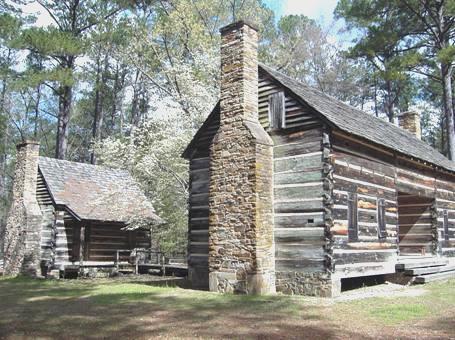
Elijah Clark home
His grave was there too, apparently moved from its former position when they flooded the valley to make the reservoir. We had coffee sitting in the Bam, looking out to the rough waves blowing across the lake. It was very cool and windy.
We crossed the Savannah River into South Carolina, driving south to Augusta, which is across the river, back in Georgia! Crossing the river for the third time, we stopped at the South Carolina Welcome Centre to pick up some leaflets to help us know what to do. We never find that the information is easy to comprehend – they never seem to have stuff that we want to know!
We crossed back into Georgia to drive through Augusta, mostly so that we could log in. We weren’t able to however, so for the fifth time we crossed the Savannah River back into South Carolina, driving through pretty rolling country to Barnwell, where we pulled in, and found that the computer had already logged in! I made a cup of tea while Adrian sent our email and web. It was now 5.30. We had thought of heading for a State Park not far away, but felt that on this windy evening, we wouldn’t like to be sitting out, or having a fire, so when we discovered that there was a Walmart on the other side of town we headed there. What’s more, we still had an internet connection!
Sunday 3rd April 109 miles
We woke to a blue sky, and realised that clocks here had gone on one our today. Adrian went out to dump the rubbish and got stung by a bee.
It was gone 10.30 new time when we left. We headed south on a pretty road until we reached Beaufort (pronounced Byew-fort, like Beaulieu). Adrian had seen a petrol station that was cheaper, but hadn’t noticed the fire engine and ambulance there! We never did find out what had happened, if anything.
We walked out around Beaufort, hoping that the parking meters didn’t apply to Sunday! It was a pleasant little place, making us think of Emsworth in Hampshire. It was a nice walk back beside the water, watching the bridge open to let a yacht through, causing traffic chaos, but it was still breezy. Crossing another piece of water we came to Lady Island, and then Helena Island. The Penn Centre – a museum about the Africans who had settled here – was closed today, so we continued to Hunting Island State Park, hoping to camp here. We immediately saw that the campsite had been very flooded. We had to drive about to see which pitch we would like to camp on. We chose one near to the sea, but were sorry to see that there were no fire rings. We came back to book in – a slow process - and bought some exorbitantly expensive barbecue fuel, so that we could have a barbie later.
We had a lovely walk along the beautiful white sandy beach as far as the lighthouse and back.
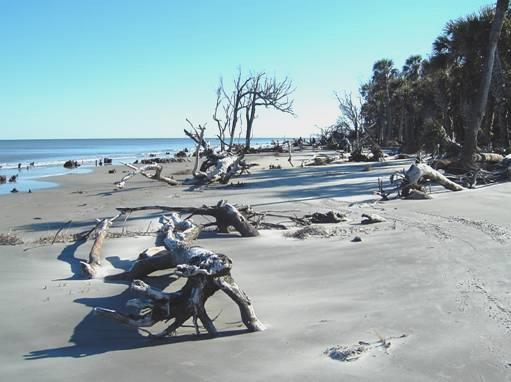
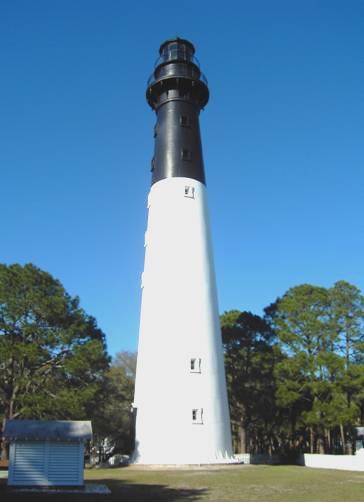
Hunting Island beach and lighthouse
Seeing that most people were having campfires, despite no ‘rings’, we decided to do likewise. It was a wonderful time sitting outside cooking our pork, baked potatoes, squash and mushrooms. The sandflies were here, but nowhere near as bad as in Georgia. We watched the lovely colours of the sky, and then the stars, walking out to the beach to see them better before coming in.
Monday 4th April 78 miles
A beautiful day. We ate breakfast inside because of the flidgies. We had a lovely walk on the beach, in the other direction from last night, then came back and lazed on the beach for a short while – bliss!
Left at midday, then drove on further into the park, stopping to walk a boardwalk, but all we saw of interest was millions of mud and fiddler crabs. Drove back into the lighthouse area to have lunch – lots of roads through jungle made us think of Fraser Island in Australia.
Drove off Hunting Island, and back to Port Royal, near Beaufort. Stopped by ‘beach’ and boardwalk with water and islands all around. Logged in and received messages from Emma and Tom. Also had online ‘conversation’ with Paul, for first time. Later had email on phone from Simon, so contact with all 4 kids on the same day.
Drove towards Charleston and stopped by idyllic spot near Parkers Ferry, by Penny Creek just before 5 o’clock.
From our spot at Penny Creek
Sat outside with a beer – lovely as sun went down, then quite cool. We became aware of fireflies outside, so went out to view them and the many stars. Top spot!
Tuesday 5th April 46 miles
The sky was blue, and it was just beautiful by the water. It was cool at first, but became really hot later (80’s) with blue sky all day. The route to Magnolia Plantation was really pretty. As the day was so fine, we had decided to visit these gardens today and leave Charleston until tomorrow.
We were greeted by beds of daffodils and narcissi at the entrance. We thought the gardens very expensive, especially as each additional thing cost extra. This meant that we didn’t visit the swamp garden, but what we saw was plenty for one day.
In fact words can’t describe how lovely the gardens were. A bit of Monet’s garden at Giverny, a bit of Sheffield Park – in fact just heaven!
Everything was just right. The daffs were going over, but the rhododendrons and azaleas were just perfect, and the weather was too. There were dozens of ponds and lakes with attractive little bridges over – my camera was doing overtime!
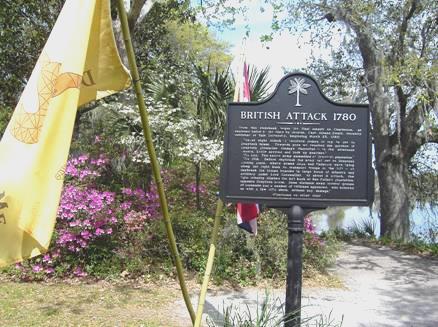

The lovely Magnolia Plantation gardens
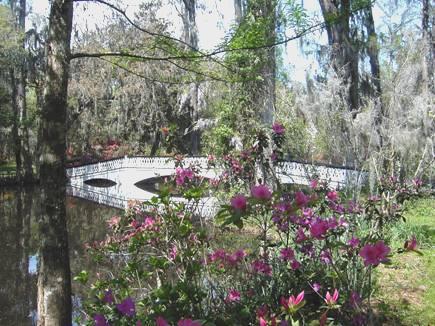
The home dated from 1676, so there was masses of history too. The British had crossed the adjoining Ashley River in their attempt to take Charleston in the Revolutionary War.
Rice was grown on the plantation until the Civil War, when Sherman destroyed everything, and with the following freeing of slaves, there weren’t enough workers for this labour intensive industry.
Our ticket didn’t include a tour of the house, which was the third on the site - the first had been burned down, and the second was destroyed during the Civil War – however, we could wander around the veranda. There was a delightful ‘National Trust’ type gift shop on the ground floor, and an art gallery too. It was in here that we met a most charming and intelligent young Lithuanian chap. He was married to an American, and had studied philosophy. He had been here 18 months. He spoke excellent English – he said that most important books were written in English, so it was necessary to know it. He had a long dark pony tail, and a nice smile, and reminded us of Gareth. The girl from the neighbouring snack bar came to join in our conversation, which is one to be treasured. We didn’t find out why such a talented chap was working as cashier in a gift store.
After lunch we went back to see the few bits we had missed – a small animal area, with beautiful peacocks, a maze which needed a bit of attention, and a tropical Barbados greenhouse – the first owners, originally British, had come here from Barbados in the 1600s. (Imagine that!)
It was 3.15 by the time we were ‘done’ – too early to go to a Walmart for the night, but too late to start out on anything else. We opted to find our way to Oak Plantation campground, which we did after deciphering the way, with the usual inadequate sign posting.
The site was quite pleasant – set in grass, and with plenty of room. There was a swimming pool – unnecessarily right out by the road – but despite the lady telling me that the water was cold, I was feeling so hot, that I had to have a try! Unfortunately, the sand flies made themselves known later, so we came in to look through the plethora of today’s photos.
Wednesday 6th April 21 miles
Another lovely day with blue sky. The flidgies weren’t too bad, so we had breakfast outside. I had a quick swim in the pool and left at 10.15, heading into Charleston.


Attractive houses in Charleston
Great difficulty in finding the tourist info, despite having it marked on a map. It was in an old railway building, and was very busy and once again, didn’t seem to have what we wanted!
We had been directed to an RV parking area, so had coffee there, before setting off to explore the town. It was a beautiful day to just wander around, but although Charleston was really pleasant, it didn’t grab us as Savannah had done. There were plenty of attractive houses, and of course so much history – the Civil war had been started by a shot fired at Fort Sumter, out in the harbour. We wandered along by the waterfront, and saw the fort way off in the distance. We had enjoyed lunch in Shuck’s, sitting outside in a covered area. Adrian had flounder, and I had a mixed seafood platter – oysters, shrimp (prawn), flounder and scallops – with baked potato. It was excellently cooked, and the atmosphere was very congenial. It seemed a good choice, popular with tourists and locals alike.
We had walked through the covered market, and came back to buy a cake from the bakery – funny that bakeries in America don’t necessarily sell bread! We kept the cake for later, but soon stopped to enjoy an icecream, sitting out in the little yard at the back.
We looked into the simple Huguenot Church, where Cathy, the ‘guide’ on duty, talked to us from ages. She reminded us very much of Linda, she was so enthusiastic about everything. She and her husband had lived in Belgium for 9 years, and she was now planning a holiday to Europe, and asked our advice on places to visit in Spain.
As we crossed the big grassy square on our way back, scores of young people were lying around in swim suits as if on the beach. A much more serious and sobering aspect of this park was the huge, unusual memorial to the Jews lost in the holocaust.
We headed out of Charleston on a huge bridge to the area called Mount Pleasant. We got some shopping in a store called Harris Teeter, rather expensive we thought, before heading for Walmart. It was now after 6.00. As we had taken so many photos yesterday, we took another lot in to be printed.
Thursday 7th April 58 miles
The morning was grey, with a few drops of rain, but became quite warm and pleasant. We left at 9 o’clock and drove to Sullivan Island. When we realised that we were near Fort Moultrie, we thought that we would pay it a visit.
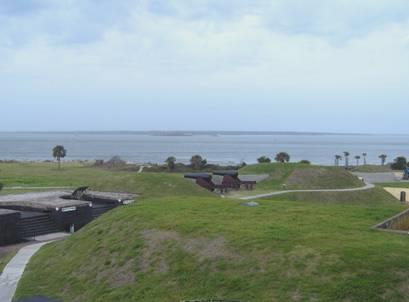
Fort Moultrie, with Fort Sumter in the distance
This fort had a long history, being built to keep out the British, who attacked it in 1776, when it was not even finished. It played a part during the Civil War, and continued through both world wars, right until 1947. The film in the Visitors Centre portrayed its different uses through the ages, and was excellently well acted, by one actor playing a different soldier during the various wars. We wandered around the fort, labelled to show the different stages of its life, but the really bad thing was the huge black mosquitoes which attacked us.
African slaves had also been landed here in the past, adding another aspect of history.
We had a nice walk on the sandy beach, just before crossing the bridge to the Isle of Palms. This residential island did not appeal to us, as the only public parking for the beach was fee paying. I had a quick walk along the boardwalk to view the pleasant sandy beach backed by accommodation, while Adrian stayed in the Bam.
We now took the road inland, stopping at Charles Pinckney National Historic Site. Pinckney had been an important American statesman, who was a big influence behind the writing of the American constitution.
Charles Pinckney site
The grounds were lovely, with an attractive house, built since he had lived here. There were many exhibits inside the house, and a short trail outside, but flurries of rain curtailed this for us.
We headed north on the busy 17, then headed inland a short way to Hampton Plantation. This was down a long, bumpy, sandy track, through wonderful huge trees. The lovely white house was a bit further on, and we chatted to 2 men who were sitting on the verandah in rocking chairs. One had been the person in charge of this house until last year, when he retired. He had returned because there is a special open day tomorrow, involving several homes in this area. Talking to them was unfortunately hampered by the presence of the mosquitoes. We opted not to have a tour of the house, but enjoyed the lovely grounds with azaleas and wisteria and huge trees, as much as the mossies allowed. Behind the house, a path went down to the Santee River – the original route to the house. Like the other plantations in this area, rice had been grown here for many years before the Civil War.
Just along the road, in Marion National Forest, we found a nice little spot to stay, but the mossies and sandflies meant that we had to shut the door but it started to rain hard anyway.
Friday 8th April 120 miles
There was some rain in the night, but it was a fine morning. We left at 8.15 and made for Georgetown.
Our first impressions of the town weren’t good, as we drove past the immense steel works and paper mill, but in fact the historic centre was lovely. It was really quiet at this early hour (9 o’clock) as we walked along a boardwalk beside the Sampit River, and then back up the attractive high street, with its brick clock tower. The town had been named for George II, and was inhabited initially by people moving out from Charleston. It certainly had character, and had a nice feel.
Adrian had to phone the storage place at Raleigh, and was dumbfounded when the receptionist said that we couldn’t have our post sent there. We then had to spend a long time sorting out where to have our post sent, opting for a Post Office which we hope will not be in an inconvenient location. It means of course that we will have to collect our post by Saturday midday, which further curtails what we do at the end of this trip. To find out this information, we had had to log in, so it all took some time.
Having sorted it all, we had coffee sitting on a seat near the river, and didn’t leave until gone 11.00. A nice town.
We had decided to continue up along the coast, which meant driving through the immense resort area of Myrtle Beach. We drove through almost non stop holiday accommodation and all the unattractive trappings that go with it. We continued through North Myrtle Beach – just more of the same.
We crossed into North Carolina, but there was no sign of a ‘Welcome Centre’, for us to get a map. Eventually we found one at Shallotte, so armed with leaflets, we tried to sort through them while we had a cup of tea.
We decided to drive to Southport, with the possibility of taking a ferry in the morning to the long peninsula south of Wilmington. There was a Walmart here, and having established that it was OK for us to stay, we drove off into the old town.
More nice houses
This turned out to be an absolute delight! The evening had turned beautiful and warm, and from the Visitors Centre we were able to pick up a leaflet (conveniently left in a rack outside the door – it was now 5.00) with a walking route on it.
This little town goes to the top of our list! It is set in an idyllic situation at the mouth of the Cape Fear River, looking across to various islands and 2 lighthouses. One of the islands, Battery Island, is a wildlife refuge, and home to thousands of ibis and other birds. We were just reading the board, saying that the birds all return in the evening, when we looked up and saw hundreds of them covering every bit of the trees on the island. It was a wonderful site! More arrived, and huge flocks would suddenly take off, cruise around, and then alight again. Added to this, we saw dolphins frolicking in the water!
The town itself is made up of streets lined with lovely old trees, and really pretty houses. All in all, a top spot! There was even the remains of an old fort – burned by the British in 1775.
To cap it all, we stopped to have supper in a waterside restaurant – a whole flounder for Adrian, and a seafood platter (prawns, oysters and fish) for me. It was far too much for me to eat, but the nice thing in American restaurants is that you are given a ‘doggy bag’ to take with you.
We walked off our meal by wandering down to the river mouth, before driving back to Walmart.
Saturday 9th April 121 miles
The morning was grey. We left at 8.20, thinking that we would have breakfast while waiting for the ferry. We arrived at the ferry, paid our money and drove on, and the boat left! It was half an hour to the Cape Fear peninsula, so we had breakfast when we got there.
We had a look at the beach, but it was very windy. A couple looked as though they were setting up for a wedding. They were carrying baskets of ferns and rolls of tablecloth, so we were amused when another couple stopped them and asked them to take their photo! It was especially funny, as all you could see was the rocky barricade to the beach!
Just along the road was Fort Fisher, site of an important battle in the Civil War. The Visitors centre (free) had an enormous amount of information and excellent displays. After watching a slide presentation about the battle, we walked around the site of the earth fort. It was very windy, so we were amused to see a photo shoot going on, with the girl wearing a skimpy white dress!
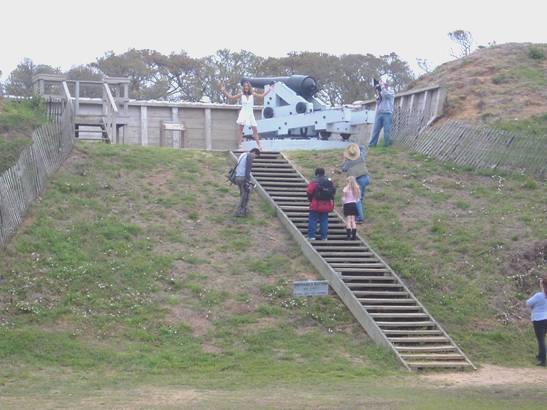
Photo shoot at Fort Fisher!
We continued up the peninsula to Wilmington, arriving at 12.30. We were aware that something was going on, but didn’t know what. We found out later that it was the Azalea parade, which was just finishing, but the carnival atmosphere continued. We drove around, and eventually found somewhere to park. As we walked down towards the waterfront, we realised that we had missed the parade, but there were stalls selling all kinds of interesting food and also crafts.
We milled with the crowd, and stopped to watch a talent contest, being held on a little stage by the water. There was a really good girl singer and then a dancer, and a little 4 year old girl who forgot everything she had to do! We walked away when a ten year old ‘queen’ starting singing, with all the razzmatazz, but the most atrocious voice!
We saw a sign saying 3000 miles to Doncaster, and on enquiring at the information booth, found that Wilmington is twinned with Doncaster (and also a town called Dan Dong in China!) The lady assistant (about our age) who told us this was of very mixed British/ French/German descent, and planned to move to Ireland in a couple of years, and earn her living as a storyteller! What interesting people we meet!
Soon afterwards we met an older man, originally from Brooklyn, who reminded us about Charlie’s wedding.
We wandered some more around Wilmington – another really attractive town, with a lot of lovely houses and tree lined roads.
We drove out through the urban sprawl, stopping at Hampstead. We drove on to Topsail Island, which was just one mass of wooden houses – no shops – and 2 uninspiring RV parks. We had a quick look at the beach – still very windy, but by now the sky was blue.
We crossed back to the mainland, and after crossing New River, saw an ideal stopping place. It was just before we entered a huge Marine base. Unfortunately, on investigating, we found that it said no camping.
This meant that we had to drive the 20 miles through the base, where the scenery was nice, and there were lots of suitable looking places to stop! Shame it was a Marine base!
We continued through ‘historic’ Swansboro (where the gentleman we spoke to this morning lived) and on to Morehead City, where good old Walmart came up trumps again. It was now 6.30, with a clear blue sky, but still extremely windy.
Sunday 10th April 62 miles
The night was really cool, but we woke to a blue sky, however it remained windy. We shopped in ‘Food Lion’, which seems to be the prominent chain here, but weren’t impressed, and ended up going into Walmart to buy some fresh bread and other goodies. Adrian had spent a long time choosing a bottle of wine, but when we got to the checkout, we couldn’t buy wine on a Sunday!
We crossed the bridge to Fort Macon, at the end of Bogue Banks Island. Again this was a State Park and was free. Each room of the fort was set up to describe a different age or aspect of the fort’s history. It had been the scene of yet another Civil War battle, and was also used during World War II. I found the exhibits meaningful and moving, and the blue sky did wonders for the photos!
We drove around to the beach area and walked down on to the beach. We found that it was quite sheltered, and we had a lovely laze on the sand. Nearby was a dad with his 6 kids, aged from about 2 to 9 years, all enjoying themselves.
We left at 2.30 and drove back over the bridge to pleasant Morehead City, and on to Beaufort, pronounced Boh-fert here.
This was another lovely waterside town. We had a really pleasant walk around, enjoying the delightful houses, all painted brilliant white. We bought a delicious icecream – sold by weight, and actually cheaper than most – which we ate sitting on a step by the water.


And the clippie
The memorable thing about this town was the open top London Bus, which took people for tours. We spoke to the driver, who said that the town had had the bus for ages, and were lucky enough to have an Englishman to look after it. We walked through the atmospheric little graveyard – all told, a thoroughly nice town.
The journey on from here was beautiful, as we crossed many bridges across an area with very few houses, and with many peninsulas, to the wildlife reserve of Cedar Island.
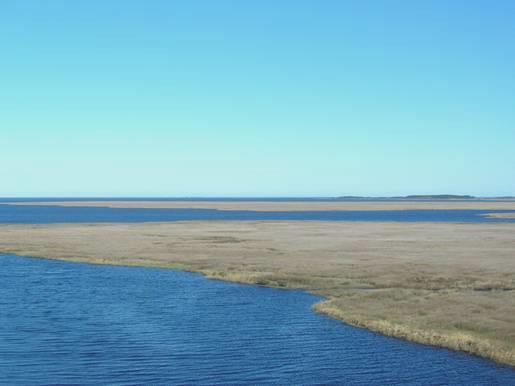
The marshes of Cedar Island
This was another delight – an expanse of swamp and grass, making us think of the Everglades. We arrived at the ferry at 5 o’clock. There was a ferry at 6.00, which we could have taken to Ocracoke Island, but this would have meant arriving in the dark. There was a pleasant little campsite here – Driftwood campsite, on a beautiful position beside the water, so we deliberated what to do, but decided to stay.
We picked a site with a lovely view over the water. As we couldn’t get any information on prices etc, we settled in and lit the barbecue.
Monday 11th April Happy Birthday Katy 11 miles
As we were awake at 6.20, we decided to go for the 7 o’clock ferry. It was an absolutely beautiful morning, still as still. The sun rose as we drove towards the ferry, and the clear blue sky stayed all day.
Just before sunrise
The crossing to Ocracoke took just over 2 hours. It was all very low-key, and we stayed in the Bam most of the time. None of the paraphernalia of the cross channel ferries – just one coffee machine and a couple of slot machines! Although we were passing between the mainland and the outer islands, we couldn’t see much of them.
We had a cup of tea, and listened to the recent recording of our travels, and before we knew it, we were approaching Ocracoke. The crossing had been really calm.
This island, about 14 miles long, is run by the National Parks as part of the Cape Hatteras National Seashore, apart from the small town of Ocracoke. It relies on tourism to survive, and the town was a hotch potch of all sorts of little tourist shops. We walked around, having had a bit more ‘breakfast’, and outside a shop selling goods made of hemp, we had a lovely conversation with the owner. He had visited Scotland last year, and has a sister living in Ireland at the moment.
There was a delightful little museum, housed in a very attractive wooden house, telling of some of the island’s life and history, and also of its dialect – a mixture of Scottish/Irish and SW of England it seems. As all over the world, the older people are concerned that the younger ones are not keeping up the traditions, and in this case the ‘Brogue’.
Another interesting thing about the island is its pirate history. Bluebeard (Edward Teach, probably from Bristol) was associated with this area – we had come across reference to him in Beaufort. He was finally caught and executed in Ocrocoke by Lieutenant John Maynard of the British Navy in 1718.
A different aspect of the island’s history is found at the ‘British Cemetery’. This tiny graveyard holds the bodies of 4 British sailors who were lost in 1942, when their ship, which was protecting US shores, was hit by a torpedo from a German submarine. It was a beautifully kept little spot, with part of Rupert Brooke’s ‘a foreign field’ on a plaque. Apparently a new Union Jack is sent out by the Queen each year to fly over the graveyard.
We had our lunch sitting at a picnic table, overlooking the water before driving round to the lovely little lighthouse. This simple lighthouse is the second oldest working one in USA. We walked inside – all you could see was the rough brickwork, and the metal spiral staircase, but the ‘guide’ did point out the huge wolf spider on the wall!
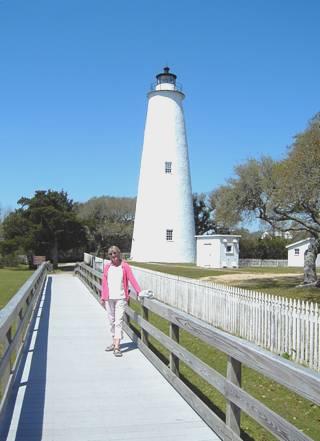
Ocracoke lighthouse
We finished our tour of the ‘town’ with a look into a really well stocked little supermarket, called a ‘Variety Store’. We bought some firewood and a few other things, then made for the National Park Campsite, a couple of miles away.
Having chosen our pitch, we walked a pleasant ¾ mile trail through a ‘hammock’, then explored the beautiful wild beach. The water was cool when we had a paddle, but we had a nice walk along the shore, and a short laze in the sun. We came back and Adrian lit the barbecue, but although the day still looked lovely from inside, the wind became really strong.
Tuesday 12th April 56 miles
The morning dawned grey and windy, but worse was to come!
We had a quick ‘blow’ on the beach and left at 9.45, heading north towards the ferry to Hatteras Island.
We stopped briefly to look at the island ponies – housed by the National Parks service in a neat compound, so now not wild at all. We walked across to see the beach here, which was topped with black sand, as we had noticed earlier, but last night it wasn’t.
We had coffee while waiting for the 11 o’clock, 40 minute free ferry. We stayed in the Bam for the crossing, which was rougher than yesterday’s, and not so attractive in the grey!
The village of Hatteras was larger and less appealing than Ocracoke, with grander houses and less character. The museum about the many shipwrecks off this shore didn’t seem to be completed yet. We had a quick look at the beach – the sand was more golden here. We were glad that we did, firstly because soon afterwards it started to rain, and the day became most unpleasant. Secondly, there was a plaque here about a group of Sir Walter Raleigh’s colonists who had found it impossible to settle here and had lit fires to alert the passing ships. These happened to be Sir Francis Drake’s lot, who took them back to England. This was in 1586.
At Frisco we visited the Native American Museum – the work of Carl Bornfriend and his wife. It was crammed with artefacts and interesting things, and we spent ages talking to Carl – a real character of 74, with strong views, but wonderful to talk to. His family name had been Bauernfreund, apparently Austrian, so he greeted us as ‘cousins’ because of our similar name. We have certainly met our fill of ‘real thinking’ Americans this time, which has been really heartwarming.
We drove on to Hatteras Lighthouse – the tallest brick lighthouse in America, and looking lovely with its black and white stripes, but it would be more enticing on a fine day! We didn’t bother to climb up it, but Adrian marvelled at the fact that they had moved it 3000ft in 1999 – imagine moving a lighthouse 200ft high and weighing 3500 tons, half a mile along a beach. It took them 23 days, jacking it along at 130 ft a day.
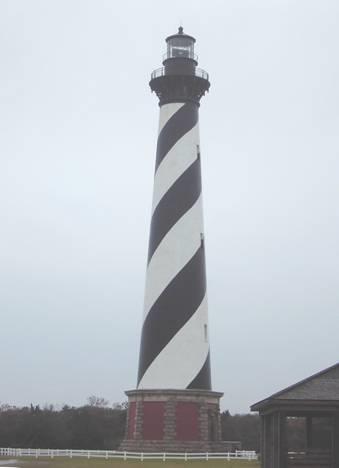
The lighthouse that moved
We now had a dilemma! We were almost out of gas (propane) – we had been looking for some for days. There was a National Park campsite nearby, but with no electricity, and we couldn’t survive the night without either.
We had tried a couple of places on the islands, but now thought that the only choice was to drive on to the KOA campsite, where we could get some. This we did, and it was with great relief that we drove out of KOA, with a full tank. We didn’t contemplate staying there, as it is so expensive, but we had to find somewhere else to stay. No Walmarts here, and the next National Park campsite was 20 miles on, so we had to try other campsites. The first we tried had no more room, as the bad weather meant that they had a problem with the beach, and were having to have large vehicles in to move the sand.
They recommended another, but try as we could, we couldn’t find the office. Eventually we did, but no-one was there. We decided to settle in – there were just a couple of places where we could safely pull in out of the wet. The first one we tried had a difficult electricity connection which got Adrian cursing in the rain! Having finally succeeded and got hooked up, we realised that the other pitch was nicer, with a view of the ‘Sound’ (the side away from the Ocean), so we moved there! It was now nearly 6 o’clock.
Wednesday 13th April 46 miles
An enjoyable day, despite the dreadful weather! The rain continued to lash down all night and all day! We both braved it to walk across to have shower/hairwash, but as we hadn’t seen a soul here, we left at 8.15 to breakfast elsewhere – another free night!
We stopped on the wildlife refuge of Pea Island to have breakfast, and at the Visitors Centre afterwards, but sadly the weather was too bad to attempt the walking trail. This was the story of the day! Wet, windy and cold (43°F)
The road was often flooded as we continued northwards. We crossed the Oregon Inlet to Brodie Island, stopping at the Visitors Centre here, by another attractive lighthouse. The lighthouses of the Outer Banks, as these islands are called, are quite a feature, and there are artistic pictures and photos of them everywhere.
We drove on, past the continual ‘kit houses’ of Nag’s Head, often painted in pastel colours. I read later that people had been holidaying here since the 1830’s, so it’s not just a recent development!
We now came to Kill Devil Hills, and the main event of the day – the Wright Brothers National Memorial. This is the site where Wilbur and Orville Wright experimented with flying, and made their first powered flight in 1903. There was plenty to keep us busy here for the rest of the day!
The terrible weather meant that it was impossible for us to climb Kill Devil Hill to the actual memorial, or walk the trail depicting the first attempts at flying.
There was a lot to see inside though, especially as more things had been added 2 years ago for the centenary. There was a full size replica of the ‘Flyer’, plus a second one in another building, and an outside version in stainless steel.
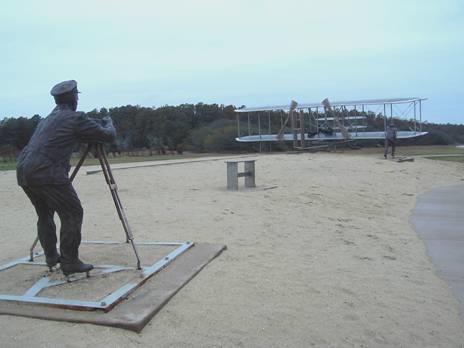
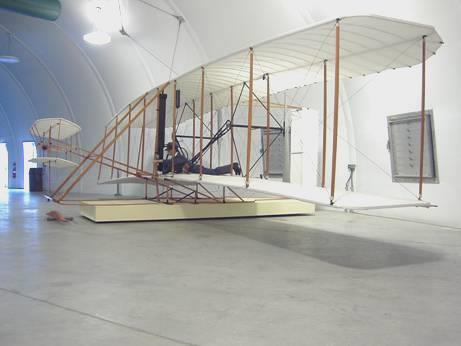
Replica of the famous photo of the first flight
We watched a long film about the history of their flying attempts. The over riding thing to me was that they experienced dreadful weather too, plus other difficulties, such as mosquitoes. Eventually, ignoring all other people’s previous work, they did everything from calculated experiments, and finally succeeded. They certainly had tenacity. The many photos and exhibits gave us a real feeling of admiration and inspiration for these two brothers and their accomplishment.
We had had lunch in between visiting the site, and had a cup of tea afterwards, while deciding what to do. We could drive back to a National Park campsite, but it had looked very windswept and wet when we passed. So, quess what! – it was on to another Walmart! In driving there we passed another Visitors Centre, named after photographer Aycock Brown, an outgoing character by all accounts, who was instrumental in highlighting the Outer Banks and its wildlife.
We reached Walmart at Kitty Hawk at 5 o’clock.
Thursday 14th April 85 miles
It was windy in the night, and although there was a cool, strong wind all day, at least it didn’t rain! In fact it was blue sky and sunshine, so good for the photos!
We drove back down to the Wright Brothers Memorial. We arrived just after the 9 o’clock opening, and today were able to do the things that were impossible yesterday – walk the trail along by the first flights, and then climb Kill Devil Hill to the memorial.
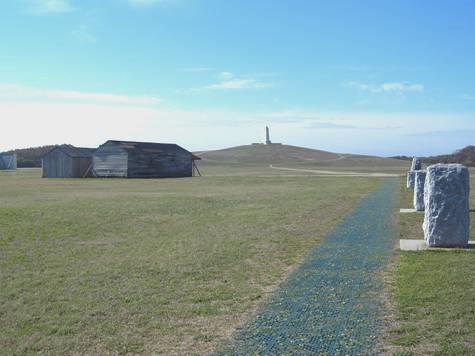

Kill Devil Hill – reconstructed sheds and first flight markers
We had said yesterday that if one of the 3 difficulties – rain, cold and wind – were missing, we would be able to face it! Well, the rain was missing, but the cold and the wind were still there! I suppose it gave us a greater understanding of what these 2 men went through to fulfil their dream!
After an hour of being buffeted, we left, and drove across to Kill Devil beach to have one last look at the ‘ocean’. It certainly looked dramatic today, with balls of foam being blown across the beach.
The rough sea at Kill Devil Beach
A few miles down the road was Jockey Ridge State Park, which has the highest sand dune in eastern U.S.
The boardwalk to the viewpoint to the dune was closed, because ‘inmates’ were working on repairing it. It intrigues and horrifies us that prison workers have large labels attached to them, and signs nearby warn of ‘inmates working’. They are just lacking the uniforms covered in arrows!
We were able to walk across the sand to view the ‘big one’ – sand dune, and out of the wind it was pleasant. We thought that Kill Devil Hill would have looked like this when the Wright brothers were attempting their flights. Their hill is now covered by National Parks neat tended grass.
We drove to another area of the park, which boarded on to the sound, and here it was calm, and we were able to have our coffee on a sloping seat by the beach. After that we had a nice walk through the dunes and back along the beach, although the wooden lookout by the beach had only its side struts remaining.
The exciting thing that happened here was that we received an email on the phone from Flora, someone I taught with in London in 1965, and had lost touch with. We had sent a letter to her recently, not knowing if it was the right person, but it was. What a lovely surprise!
We now crossed to Roanoke Island – an island with a lot of history. This is where Sir Walter Raleigh had brought his group of colonists in 1585. This first group had struggled to survive and been taken back to England by Sir Francis Drake, who just happened to be passing! – we had seen a plaque about this the other day. A later group who came out in 1586, became know as the ‘lost colony’, and a legend has been built up around them. After a short period on Roanoke, their leader, Ralph Lane, left for England, to get extra support. He found this difficult, and when he finally returned in 1590, there was no sign of the colonists. It remains a mystery to this day.
At the Fort Raleigh National Historic Site, there was a waterside theatre, rather like Mynack theatre in Cornwall, where, since 1937, they have performed a play about these ‘lost’ people. A lot of theories have been put forward and investigated, but it seemed to us that the legend is more important than the fact!
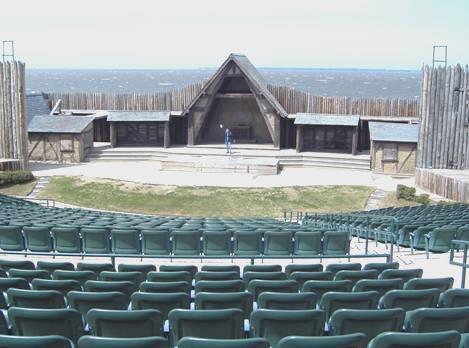
Theatre where ‘The Lost Colony’ is re-enacted
The whole site was drooling with Elizabethan history – the most interesting thing to us was a map of East Budleigh – a stone’s throw from Emma – where Raleigh was born. It was hidden behind a costumed figure of Elizabeth 1. We walked a nice trail with quotes by Thomas Hariot, the scientist of the time, and saw the reconstructed earth fort like the one the colonists had built. Then we watched a film about them.
There was another piece of history connected with the island. By 1862, the island had been captured by the Unionists during the Civil War. Freed slaves from across North Carolina had gathered here, as it was a haven, where they could live a free life. There were 3,000 of these people living here, starting a new life after their cruel bondage. For 5 years they lived a life of freedom, but after the war, all the freed slaves became second rate citizens, staying that way for another 100 years. In the Visitors Centre, there was one small display about it. When we enquired, we were told that there was another small information board near the bridge to the mainland. We stopped off to see it, but were dismayed that this was all that there was.
Earlier on the island, we had looked in at the so-called ‘Maritime Museum’. It was actually just a boat building shed, where a galleon called the Elizabeth II had recently been built, and was housed in a nearby museum. We saw the boat across the water. In the boat shed were 2 men, one who had a son living in Bristol, and the other who was a bit of a Johnny (Coxhead) know-all. It seems that schoolchildren were given the task of building and sailing small boats, in the hope of giving them a sense of achievement. We liked the ideals, but were disquieted by the ‘Clever Dick’ attitude of this well meaning man.
Now it was time to leave the islands, and we crossed on yet another long bridge to the mainland, driving through a wildlife refuge. We drove around the pleasant town of Columbia, and through Creswell, which had a lot of character. It seems strange that this area, which was the first to be visited by the British, is still very low-key and unspoilt.
We arrived at Pettigrew State Park, on Lake Phelps, and adjacent to Somerset Place Plantation, which was started by a man called Collins, from Somerset in 1785. The campsite was flooded in places, and we were the only people there.
Friday 15th April 155 miles
A day of pretty houses and high winds! The wind had blown violently all night, keeping me awake as it was so noisy in the trees. We were pleased that we had parked as far away as possible from the really tall trees.
Although it was blues skies the wind didn’t let up all day, so we decided on a tour of the ‘Historic towns’, mostly with English sounding names.
We were sorry not to be able to visit Somerset Plantation next to where we had camped – it would have been lovely on a nice day. We stopped to take a photo. I got out of the Bam to take it, and it felt as though I was in the Antarctic!
We retraced our steps through the film set looking town of Creswell, then across a long bridge over the Albermarle Sound to Edenton. This is the second oldest town in North Carolina, and like all the towns we visited today, it had lots of nice houses. It also has a church, St. Paul’s, dating from 1736. We asked about it in the Visitor’s Centre, and found that it was just across the street. We could manage that! It had boxed pews rather like St. Hilda’s church in Whitby.

Box pews in St. Paul’s Church Edenton 1736
Now it was on to Windsor, and here we had a walk beside the Cashie River, where in former times it had been a busy port. This was another pretty town, with lots of white blossom, in our eternal spring!
At Williamston we drove around yet more nice houses, then turned off at Jamesville.
We now backtracked to Plymouth, scene of a big Civil War battle. They were setting up to do a re-enactment this weekend, as it was the anniversary of the battle. We didn’t envy them putting up their tents. The water was blowing up the river like a bore. This was another pretty town.
We now drove through pleasant, flat, agricultural land, where the sandy soil often blew up like a dust bowl when the wind howled. We were heading for Bath, the oldest town in North Carolina, dating from 1705.
There was a lot of history here, as we found when we watched the short film in the Visitors Centre. The founder of the town was a man called John Lawson, who wrote intricate diaries of his exploits, but was sadly killed by Indians in 1715. The simple St. Thomas’ church dates from 1734, the oldest in North Carolina.

St Thomas Church, Bath 1734
The town was also home to Blackbeard the pirate. Another visitor of interest was Edna Ferber, who wrote the book ‘Showboat’ after coming to Bath. I remember seeing the show of that name as a child, and it has been filmed more than once, with its well known song ‘Ole Man River’.
Several of the houses have been well restored. We walked around, and looked into the Van der Veer home, which has been set up as a sort of local museum.
Finally we came to Washington, another waterside town, with a historic centre. It was 5.30 when we pulled in to Walmart – the busiest and noisiest we have stayed in!
Saturday 16th April 137 miles
It was the coldest night yet, and a noisy lorry came in and ran its engine all night! Adrian had moved 3 times last night too, to try to find the quietest spot!
It was a greyish start to the day, and still cool and windy, but ‘turned out nice’.
We headed off to Raleigh, driving through pretty, flat country, with a lot of trees. Raleigh is part of the ‘Research Triangle’, with neighbouring Durham and Chapel Hill – a big medical research area, with universities and hospitals in an attractive leafy location.
The last bit of road to Raleigh was a slow dual carriageway, with road works, and a lot of traffic. We were in a hurry, as we wanted to call in to the storage place as no-one will be there on Monday morning when we leave. After that we wanted to collect our post from a post office in Durham. All did not go to plan!
We stopped to get some fuel, and cursed the vast number of traffic lights, which seem to keep you waiting so long!
We navigated our way to the storage place, and Adrian spent some time sorting out the paperwork. We now headed for the post office, arriving in good time for the 12.30 Sat closing. While Adrian went in to collect the post, We were flabbergasted once more – there was no post for us! It seems that you can’t have post sent here if you don’t live in the area! I went in to try my luck, in case the man had got it wrong. Another long wait in the queue, only to be told a similar thing (only this time the man had asked me for my address, and when I hesitated, he impatiently said ‘where do you live?’). On re-reading Lonely Planet, we came to the conclusion that ‘post restante’ has to be sent to the town’s main post office. This wasn’t open today anyway, even if ours had been sent there. If only they had let us have it sent to the storage place!
Giving up on the post idea, we now made our way to nearby Bennet Place. This was a very fitting end to our tour this time, as it is the site where Sherman and Johnson signed a treaty to end the Civil War in the south east of USA (the war continued a bit longer in other places).
The two generals had taken over a farm house here, to use for their negotiations. The farm buildings have been accurately reconstructed, and in the Visitors Centre there were a lot of excellent displays. Also we watched a superb short film which gave a concise history of the war.
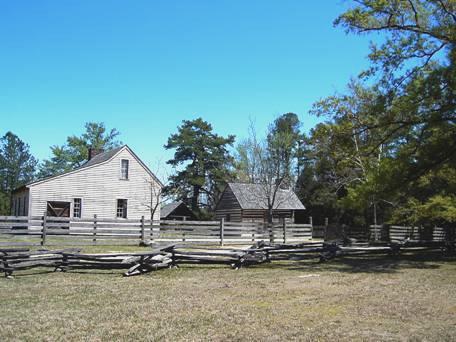
Bennett Place – end of the Civil War in the S.E.
We were able to have lunch at a picnic table outside, although it was a bit breezy, and then have a short walk in the woods. We both felt overawed at the thought of such an important event having happened here.
It wasn’t far to the RV place that we were hoping to stay at – the only one in the area, Birchwood RV Park. It was time to be flabbergasted yet again! The surrounding area was very pretty, with trees everywhere, and the RV Park was rather a ramshackled affair. We located the manager, a small, energetic oriental man, who said that he had one space left, with water and electricity, but no full hook-ups, and no showers! The last night of our trip is the ONLY time when we need a full hook up, as Adrian needs to empty and clean out the tanks! Then we need to use the site showers/toilets.
What to do? As this was the only place around, we said that we would stay tonight. There was a washing machine, which is our other need at the end of a trip (and propane and a small shop, had we needed them!).
We set to and put in one load of washing. When we reached our spot, we found that next door had plugged in to our electricity! The man wasn’t around, but did return soon, and he and Adrian had a long chat, so that one was sorted out!
We spent some time cleaning and cleaning up, and we’ll leave tomorrow to look after itself – there is a state park, which doesn’t open until May, and another park campsite, which doesn’t have an office at the weekend!
At least the sun was shining!
Adrian cooked bratwurst, baked potatoes, mushrooms and squash on the barbie, and afterwards we went in to chat to John and Bev, the couple next to us, from Michigan.
3271 miles to Southport, England
Orville at the controls
Close-up of the Memorial
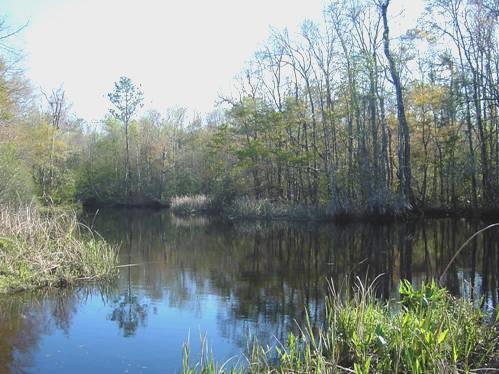
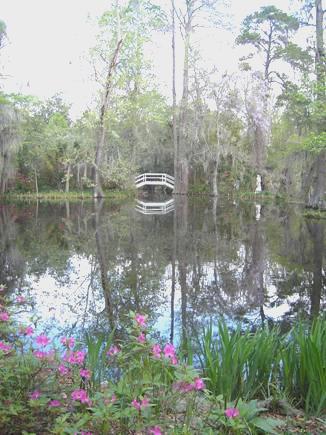
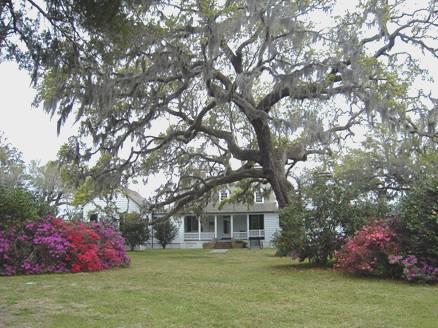


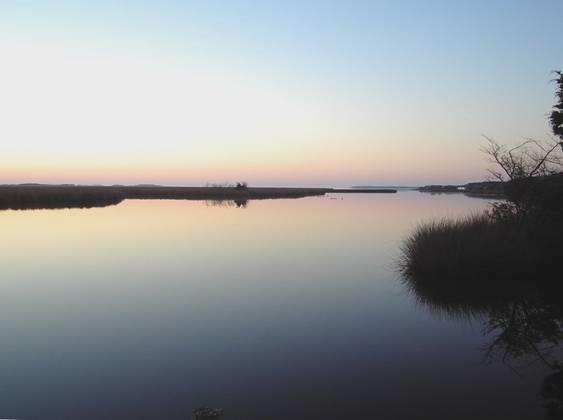

Washington to Raleigh, North Carolina
What’s this? A London bus?









